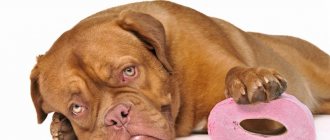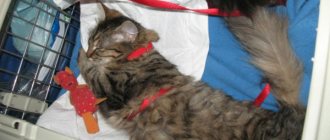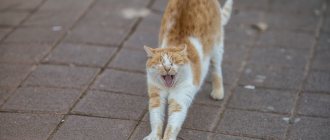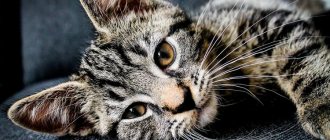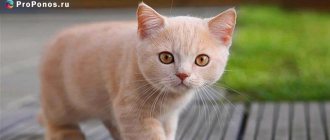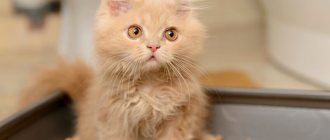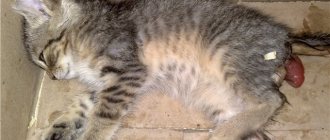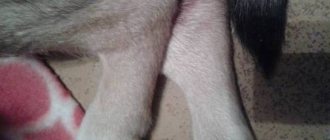A laxative for cats helps relax the intestinal walls, while maintaining their tone and without disturbing the microflora. Every cat owner should have laxatives in their first aid kit. Problems with defecation as a result of malfunctions of the digestive tract can cause intoxication of the entire body, poisoning the pet with toxins. In severe cases, even death is possible, which is why the symptoms of constipation and digestive tract disorders should be recognized in time in order to eliminate the problem in time.
Problems with defecation are solved with drug therapy, home remedies, and also with the help of traditional medicine recipes.
When does a cat need a laxative?
Cats should be given a laxative only after the cause of their difficulty in defecation has been determined. Constipation can be caused by poor nutrition, stress, moving, or fear. Cats sometimes experience constipation caused by emotional and psychological factors. For example, constipation may occur due to rejection of the tray, filler, new house, or simply due to the appearance of a new pet in the house.
It is necessary to find out the specific reason, try to create comfortable conditions for the pet to go to the toilet, change the litter, use anti-stress sedatives prescribed by the veterinarian. Constipation, which is caused by a change in food, the introduction of a new product into the diet, or a transition to a different type of food, begins to be treated with the use of a special diet or switching to dietary nutrition.
Constipation can also occur with:
- eating diet foods with low protein content;
- the presence of a tumor in the digestive tract;
- dehydration of the body;
- inflammatory processes in the rectum;
- orthopedic problems, when the pet finds it difficult to sit down and defecate comfortably;
- sedentary lifestyle;
- presence of megacolon disease;
- renal failure;
- helminthiasis;
- the presence of hairballs in the stomach;
- the presence of growths, inflammation on the body.
Constipation in a cat is detected by the absence of defecation for more than 2-3 days. At the same time, the cat meows, makes unsuccessful attempts to sit in the tray or simply in a hidden corner, wanting to free itself from uncomfortable feelings.
The cat may constantly visit the toilet and defecate with great difficulty. The feces have the form of dense nuts or a watery appearance. These symptoms indicate the presence of chronic constipation.
Both acute and chronic constipation is accompanied by weakness, lack of appetite in the animal, nausea and vomiting (rarely). A cat may refuse to eat and lose weight, some stop licking themselves, and their nose is completely dry.
Laxatives for cats should only be used after consultation with a veterinarian. Constipation can be confused with intestinal obstruction, and this pathology must be treated in a different way, using other medications.
The drugs are mainly used for cats after sterilization/castration, or when the animal has not had bowel movements for more than three days.
Laxatives should not be used if constipation is caused by swallowing hard objects or bones, or if there are traces of mucus or blood in the stool.
Choosing a laxative for a cat
Laxatives help relieve constipation, but their uncontrolled use can lead to unwanted effects. Let's look at the main types of medications and traditional medicine recommended by practicing veterinarians.
Medications
Based on its composition and type of effect on the animal’s body, cat laxatives are divided into several large groups.
- Bulk-forming laxatives.
- Osmotic laxatives.
- Lubricants.
- Stool softeners.
- Laxatives with a stimulating effect.
- Enema.
Bulk-forming laxatives
These are drugs that pass through the cat’s gastrointestinal tract in an undigested state. In the large intestine, they expand due to the absorption of water - the animal’s stool becomes softer and larger. This group of drugs has a long period of action - from 12 to 72 hours. Drinking plenty of fluids is prescribed for the entire course of taking the drug.
Indications: chronic constipation and its prevention; irritable bowel syndrome, hemorrhoids, anal fissures, pregnancy.
Dosage: 0.5 teaspoon for each meal. The dose of the drug is gradually reduced.
You should not give it: if the animal requires emergency help, it is better to use another type of means.
Contraindications and side effects: individual intolerance and allergic reactions. They affect the absorption of other drugs.
Recommended drugs:
- Metamucil (Metamucil),
- preparations based on flax seed.
Osmotic laxatives
This type of medication works by pulling water from the cat's body into the large intestine. Therefore, while taking them, it is necessary to monitor compliance with the drinking regime - the cat should drink a lot. The increased volume of feces with the help of liquid puts pressure on the intestinal walls, causing the urge to defecate.
The composition of osmotic laxatives is based on lactulose, which acts at the level of the colon. Lactulose suppresses the growth of pathogenic flora and forms beneficial intestinal microflora. The laxative effect occurs within 24-48 hours.
Indications: acute and chronic constipation, dysbacteriosis, postoperative period (sterilization).
Dosage: 0.5 ml per 1 kg of live weight 2-3 times a day.
Should not be given: for emergency use.
Contraindications and side effects: chronic renal failure. With prolonged uncontrolled use - loss of electrolytes, dehydration.
Recommended drugs:
- Lactusan (syrup or tablets);
- Duphalac (powder or syrup).
Lubricants
Preparations with a lubricating effect are most often used to combat hairballs. So-called malt pastes lubricate the intestinal walls, facilitating the natural removal of hairballs from the body. The composition of lubricants includes vitamins: A, E, D.
Recommended drugs:
- GimCat Malt-Soft Paste Extra;
- Beaphar Malt Paste;
- TRIXIE Malt'n'Grass.
This group of laxatives also includes vaseline oil and products based on it. The oil included in their composition envelops the intestinal walls, helping to remove foreign bodies, bezoars, and hard stones.
Vaseline oil is a safe and gentle product. It is not absorbed, does not accumulate in the body, and does not cause allergic reactions. Once in the cat's body, the oil creates a slippery film on the intestinal walls. This helps to naturally remove accumulated stool. Vaseline film prevents toxins from being absorbed and prevents the development of intoxication in the animal’s body. The laxative effect occurs after 3-6 hours.
Indications: episodic constipation, postoperative period (sterilization/castration, abdominal surgery), postpartum period, coprostasis.
Recommended dosage: 1 ml of oil per 1 kg of live weight after 8-10 hours.
Should not be given: for chronic constipation.
Contraindications and side effects: intestinal bleeding, hemorrhoids in the acute phase. In case of long-term use, the reflex to defecation may decrease. Reduces the absorption of fat-soluble vitamins (A, D, E).
Recommended drugs:
- Bimin;
- Vaseline oil.
Stool softeners
The effect of the drugs is due to the salts included in their composition. They reduce the surface tension of the animal's stool, allowing it to better absorb water. Emollients can be used very carefully, only as directed by a veterinarian (prescription). The effect occurs within 3-6 hours.
Indications: intoxication, episodic functional constipation, bowel cleansing before abdominal surgery (sterilization).
Dosage: strictly as prescribed by the doctor.
Do not give: if the cat requires long-term treatment.
Contraindications and side effects: pregnancy, lactation. With prolonged uncontrolled use - an uncontrollable laxative effect.
Recommended drugs:
- Docusate sodium is a fast-acting laxative.
Laxatives with a stimulating effect
Stimulant laxatives act by irritating the muscles of the colon, thereby increasing its activity. Prevents hardening of feces. They are characterized by fast action. Prescribed by a veterinarian. The effect occurs 6-10 hours after administration. The duration of use should not exceed 7-10 days. Uncontrolled use may cause dehydration.
Indications: acute constipation.
Dosage: calculated individually by a veterinarian.
Should not be given: for chronic constipation.
Contraindications and side effects: pregnancy, lactation. With prolonged uncontrolled use, “lazy” bowel syndrome is formed, chronic constipation develops, and the risk of tumors in the colon increases.
Recommended drugs:
- Bisacodyl is a strong laxative.
Enema
A cleansing enema helps clear the cat's intestines of stagnant fecal matter. An enema is done with warm boiled water or chamomile infusion. It is best not to do it yourself at home, but to entrust this procedure to specialists.
Important!
Human laxatives are not suitable for cats.
Folk remedies
In addition to medicines, the following are used in folk medicine:
- Pumpkin. Freshly squeezed natural pumpkin juice is a natural laxative for cats. The juice is mixed into food or poured into the animal’s mouth using a syringe. The recommended single dose is 0.5 teaspoon. As a preventive measure, a little boiled pumpkin is included in the animal’s daily diet. For convenience, boil the peeled pumpkin for 7-10 minutes and grind in a blender to a puree.
- Milk. The most common folk remedy with a laxative effect. Milk is given warm several times a day. Do not give to cats with lactose intolerance. In large quantities it can cause diarrhea.
- Condensed milk. Condensed milk diluted with raw water (from the tap) acts as a laxative. Condensed milk is diluted with water in a ratio of 1:3. The resulting mixture is given to the cat one tablespoon at an interval of 3-4 hours, no more than 5 times a day. This method should not be abused. This method is not used in cats with diabetes.
- Olive, flaxseed and coconut oil. A small amount of oil (¼ – ½ teaspoon) is mixed into the animal’s food. Vegetable oils should be given in doses and with great caution - they negatively affect liver function.
- Psyllium seed husk is a natural enterosorbent that restores intestinal microflora. The husk is crushed in a coffee grinder or blender and mixed into cat food, ¼ - ½ teaspoon per meal.
- Unhulled oat grains have a mild laxative effect. Add 50 grams of grains to a glass of milk and boil for 30 minutes. Cool the finished broth to room temperature and give a teaspoon 2 times a day.
- Oat bran is a good source of fiber, an analogue of the drug Metamucil. Give half a teaspoon with each meal. Long-term use is allowed.
- Decoctions and infusions of herbs: rhubarb root, buckthorn, borage, knotweed, elderberry, flax seed, centaury. A tablespoon of dry herb is poured into a glass of boiling water and left in a water bath for 20 minutes. The resulting broth is cooled for half an hour, filtered, squeezing out the raw materials. Bring the infusion to 200 ml by adding warm boiled water. Give 1-2 teaspoons 3-4 times a day.
If the cat does not have a bowel movement within 8-12 hours after taking the folk remedy, it must be taken to a veterinarian for a diagnosis and treatment.
Herbal remedies for constipation
Collection No. 1
- Peppermint leaves – 1 part;
- Pharmaceutical chamomile – 1 part;
- Stinging nettle – 1 part;
- Horse sorrel – 1 part.
Collection No. 2
- Buckthorn bark – 3 parts;
- Stinging nettle – 2 parts;
- Yarrow – 1 part.
Herbal teas are prepared and used in the same way as herbal decoctions.
Important!
According to veterinarians, it is better not to use vegetable oils. They are absorbed into the intestines and cause pain. An overdose of vegetable oils causes problems with the liver.
How to help kittens with constipation
A kitten's unstable digestive tract can react by delaying bowel movements to the slightest error in nutrition. The normal stool frequency for kittens is at least once a day. If you notice signs of constipation: hard feces, painful bowel movements, hard belly, you should:
- find the reason
- perform a first aid.
To determine the cause, the kitten is shown to a veterinarian. Before visiting the clinic, you can use one of the following proven methods:
- drink milk or condensed milk diluted in raw water;
- adjust the water balance, offer the kitten something to drink, and if it refuses, give it something to drink using a syringe;
- massage the tummy with light longitudinal movements from the chest to the tail, it is best to do this with a moistened cotton pad - this is reminiscent of the licking of a mother cat;
- give vaseline oil - 0.5 ml per 1 kg of weight 2-3 times a day;
- make an enema with chamomile infusion using a small syringe or syringe (10 ml) - lubricate the tip with Vaseline;
- put a rectal suppository made from a small smooth soap soaked in water.
It is strictly prohibited to independently select medications for a kitten. All medications must be prescribed by a veterinarian.
Kittens are prescribed mild laxatives based on lactulose in powders or syrup with a safe effect.
Recommended drugs:
- Vetelact;
- Lactusan;
- Duphaston;
- Prelax.
The drugs are given orally using a syringe or mixed into milk. The powders are pre-diluted in a small amount of boiled water at room temperature. The recommended dosage for kittens is 0.25 ml per 1 kg of weight 2-3 times a day.
Laxative in the postoperative period
After sterilization (castration), due to the use of strong anesthetic drugs, the animal experiences difficulty in bowel movements. To prevent bleeding and suture dehiscence, the doctor prescribes laxatives and prescribes a special postoperative diet.
What to give?
To help your cat restore the process of defecation, you can use Vaseline oil or the laxative Duphalac in syrup. To do this, oil or medicine is drawn into a syringe without a needle at the rate of 0.5 ml per 1 kg of animal weight.
How do laxatives work?
Laxatives for cats are divided into several groups. The effects of these medications differ from each other.
The main action of laxatives for cats is aimed at:
- stimulation of peristalsis of the large intestine by mechanical or chemical irritation of the nerve endings located on its surface. This group includes medicines containing isophenine or phenolphthalein, as well as natural medicines based on buckthorn bark, hay, and rhubarb.
- softening stool and making it easier to slide. This group of laxatives includes vegetable oils (olive, vaseline, flaxseed, sunflower, castor).
- slowing down the process of reabsorption of water through the walls of the colon, which contributes to the dilution of feces and its easy removal. Such agents with a laxative effect include sorbitol, xylitol, agar-agar, and magnesium.
All laxative drugs are used for symptomatic treatment and have a temporary effect. Their action is aimed at reducing the severity of symptoms and eliminating unpleasant signs. For complete treatment, it is necessary to identify the cause of constipation through an examination, which may include blood tests, stool tests and an ultrasound of the pet’s abdominal organs.
Treatment options
Knowing the possible ways to treat constipation in a cat, you can easily avoid dangerous consequences. In the absence of accompanying symptoms and a single problem with bowel movements, you can cope with the situation on your own.
Drug therapy
It is recommended to consult a veterinarian before taking medications. By describing the animal's condition, you can find out what can be given to a cat for constipation and what cannot be given. Depending on the situation, your doctor may recommend the following types of laxatives:
- Volume-forming agents (Metamucil)
. They attract additional moisture from cells, increasing the volume of feces. Not suitable in an emergency situation.
- Emollients (Docusate sodium)
. Suitable for emergency emptying. Contraindicated when feeding or expecting offspring.
- Osmotic (Duphalac, Lactusan)
. Softens stool and stimulates peristalsis. Not suitable for urgent care, but have a beneficial effect on microflora.
- Lubricants (pastes for hair removal)
. They ensure free sliding along the intestinal walls by moisturizing them.
- Stimulants (Bisacodyl)
. They stimulate the contraction of intestinal muscles and help get rid of obstruction in a short time. Contraindicated for pregnant and lactating pets.
Self-administration of laxatives can lead to severe dehydration, so do not experiment on your pet. Sometimes it’s enough just to change the filler or change the diet. And leave anything more complicated to the doctor.
Castor or Vaseline oil
The most popular folk remedies are castor oil and Vaseline. Vaseline oil does not accumulate in the body, so it is difficult to overdo it with the dosage. Veterinarians recommend giving 1 ml per 1 kg of animal weight using a syringe or syringe. Once in the body, the oil softens stagnant feces and promotes their removal.
But it’s better to be careful with castor oil. The cat's body is not compatible with it, so instead of relief, you will cause your pet severe stomach pain.
Is it possible to give an enema?
Treatment of constipation in cats and kittens at home with an enema is permissible only after examination by a doctor. This procedure is prohibited for chronic pathologies and obstruction, as it can aggravate their course.
Working with an enema is complicated by unpleasant sensations. In the absence of skills, the pet will constantly break out, and a successful outflow of feces can “decorate” a considerable part of the room. If the veterinarian gives the go-ahead and you are not afraid of difficulties, read the detailed instructions and proceed with the procedure.
Why you shouldn’t use folk remedies
The main danger of folk remedies is the unpredictability of the body's reaction. The cat may develop allergies or severe poisoning. Healing decoctions are good in complex therapy, but only under the guidance of a doctor who has checked the absence of an allergic reaction to the main components. It will not be possible to eliminate the problem without more effective drugs.
Nutrition correction
At the initial stage of the disease (partial emptying of small balls), you can try to improve nutrition. Start feeding your pet:
- fractionally, increasing feedings to 6 times a day;
- more liquid food, soaking dry granules or adding broth to prepared dishes;
- lean ground meat and raw liver;
- ground pumpkin, carrots and beets, or simply feed the cat their juice through a syringe;
- milk porridges and fresh fermented milk products (yogurt, kefir).
Avoid foods that increase gas formation (legumes, yeast products), bones and cartilage. Temporarily eliminate rice, which has a strengthening effect, from your diet. Add a small amount of bran and vegetable oil to the dish (0.5 tsp per day), which stimulate peristalsis.
When using dry food, pay attention to the veterinary ruler marked i/d. These products are rich in coarse dietary fiber, as they are designed for those who suffer from digestive problems.
Massage
Not all pets are ready to let a person near their belly. If the animal trusts you, then try to accustom it to a light massage. Stroke your pet's belly clockwise at any free time. The procedure can be carried out with bare hands or a cloth dipped in cool water.
Are the items in a person’s first aid kit suitable?
Not all products in a human medicine cabinet are suitable for cats. Some of them can cause intoxication and even death in pets. It is very difficult to correlate the dose intended for humans with the average weight of a cat (3-5 kg).
It is safer when the drug is chosen by a veterinarian. Drug treatment should be used only after examination by a specialist and only with the use of approved drugs in the dose prescribed by the doctor.
Medicines
Based on their composition and type of effect on the animal’s body, laxatives are divided into the following groups:
- bulk-forming laxatives;
- osmotic laxatives;
- lubricants;
- laxatives with a stimulating effect;
- enemas.
- Bulk-forming drugs include medications that pass through the gastrointestinal tract in an undigested state. They begin to expand in the colon by absorbing water, which helps soften the stool and increase its weight. The period of action of these funds ranges from 12 to 72 hours. Taking drugs in this group should be accompanied by plenty of fluids. Drugs in this group are prescribed for chronic constipation or for their prevention, irritable bowel syndrome, hemorrhoids, anal fissure, and during pregnancy.
The recommended drugs in this group are Metamucil and drugs based on flax seeds.
- Osmotic laxatives help draw fluid from the cat's body into the large intestine, and therefore it is necessary to provide cats with plenty of fluids while taking these drugs. Fecal masses increase with the help of fluid and begin to put pressure on the intestinal walls, causing the urge to have a bowel movement.
These products contain lactulose, which acts at the level of the colon. Lactulose suppresses the growth of pathogenic intestinal microflora. The laxative effect occurs after 24-48 hours. These drugs are prescribed for acute and chronic constipation, dysbacteriosis, and after surgery (sterilization or castration).
Recommended medications are Lactusan, available in the form of syrup or tablets, and Duphalac. Duphalac can be given to cats in the form of syrup or powder. The dose is 0.5 ml per 1 kg of cat weight, 3 times a day.
- Lubricants or malt pastes are used to combat hairballs. They lubricate the intestinal walls, helping remove hairballs from the body. The composition of lubricants includes vitamins A, E, D. These preparations include TRIXIE Malt'n' Grass, Beaphar Mailt Paste.
This group of laxatives includes petroleum jelly and products based on it. Vaseline oil coats the intestinal walls, helping to remove foreign bodies, hard stones and bezoars. The substance is considered safe and mild. It is not absorbed, does not accumulate in the body, and does not cause allergies. Vaseline oil, getting inside, creates a slippery film on the walls of the intestines, which allows you to naturally remove accumulated feces. In addition, petroleum jelly protects the body from toxins, preventing them from being absorbed, which helps prevent intoxication of the cat’s body.
Recommended drugs are Bimin, vaseline oil.
The laxative effect occurs after 3-6 hours. Dose – 1 ml of oil per 1 kg of pet’s weight. This group of drugs is used for episodic constipation, after surgery (sterilization, castration, abdominal surgery), in the postpartum period, and for coprostasis.
- Stool softeners reduce the surface tension of your cat's stool, allowing it to more actively absorb water. The mechanism of action of the drugs is determined by the salts they contain. These medications should be used very carefully, only as prescribed by a doctor. The effect of the drugs occurs after 3-6 hours.
This group of drugs is prescribed for intoxication, occasional chronic constipation, and for cleansing the intestines before abdominal surgery or sterilization.
Docusate sodium is prescribed, which is a fast-acting remedy. The dose is determined by the doctor strictly on an individual basis.
- Laxatives with a stimulating effect act by irritating the muscles of the colon, activating its functionality. The drugs improve the structure of feces, facilitating the act of defecation. The effect occurs after 6-10 hours; it is prescribed for acute constipation.
The recommended medication is Bisacodyl.
- An enema helps empty the intestines of stagnant feces. You need to do an enema with warm boiled water or chamomile infusion. The procedure must be performed by a doctor in a clinical setting.
Medicinal laxatives for cats: instructions for use
Prebiotics Lactusan and Duphalac are sold in a medical pharmacy. They are syrup. They act gently and have no side effects. The approximate dose is 1 ml/2 kg of live weight. Apply 2-3 times a day for at least three days in a row. It can be given as a preventative to cats prone to constipation. Disadvantage: slow action. Lactulose is broken down by lactic acid bacteria in the large intestine. To achieve a concentration capable of having a bactericidal effect, it takes 2-3 days. There are no components in the medicines that could have a toxic effect, so it is difficult to overdose on the prebiotics Lactusan and Duphalac.
Laxative Bimin is designed to relieve and prevent constipation and helps remove hairballs. The drug is used once a day, in the morning, before feeding. Dosage - 1 ml/kg body weight.
Saline laxatives Laxigal and magnesium sulfate should be administered under the supervision of a veterinarian to avoid complications. Half a thirty-gram bag of Epsom salts is diluted with water and poured into the cat. The drug is bitter, the pet will resist. Laxigal is given at the rate of 1 drop/2 kg of live weight. Relief occurs after 1/4-1/2 days.
The fastest way to induce a bowel movement is to give an enema. The best option is the drug Microlax , which is a gel placed in a tube. An adult cat is given a full portion, a kitten is given a half portion. In most cases, defecation occurs within a quarter of an hour. However, in order to avoid injury, as well as the development of side effects, the administration of an enema should be entrusted to a veterinarian.
Home Remedies
Sometimes the use of laxatives in cats is not advisable. You can replace medications with products prepared from traditional recipes. Laxatives can be prepared at home using decoctions of medicinal herbs, raw vegetables, vegetable oils, and condensed milk. Massaging your pet's belly is also an effective way.
You should get your veterinarian's approval before using homemade laxatives. It is important to begin treatment after the cause of the pathological condition is identified.
- Vegetable oil can be added to your cat’s low-fat food, normally 1-2 drops. The method can only be used for adult cats and male cats no more than once a month. Kittens are not allowed to give vegetable oil. Overdose in order to obtain a quick effect is not allowed. Large amounts of oil negatively affect the liver of cats.
- Condensed milk helps normalize intestinal function in cats and soften feces. The laxative effect of condensed milk will be ensured if you give your cat a drink made from a mixture of condensed milk and raw tap water (1:1). The drink can be given to your pet no more than once a day, as the liquid can cause diarrhea.
- Raw vegetables are one of the effective homemade laxatives. This is a useful and effective way to treat constipation in cats. Vegetables should be fresh and juicy. It is best to use them in the form of freshly squeezed juice, which is poured into the cat's mouth using a syringe or pipette. Every day, a pet with problems with bowel movements should be given about 30 ml of juice. You can also add a small piece of grated vegetable weighing 30g to your cat’s food. It is recommended to use beets, carrots, and cauliflower.
- with cleansing enemas . But if the need arises, you can carry out the procedure at home. In this case, the cat should be fixed on the table and a tray should be placed next to it for emptying. The tip of the enema should be smeared with Vaseline, and then the air should be released from it. A ready-made chamomile decoction or warm water in an amount of 50 ml (pre-boiled) should be taken into an enema and inserted into the cat’s anus.
Within a few minutes the cat will empty its stomach. After the procedure, it is recommended to use suppositories to relieve inflammation.
- Abdominal massage should be carried out comprehensively. The cat needs to be given a laxative, then begin to massage the fluffy’s tummy with light clockwise movements. It is recommended to carry out the procedure 3-4 times a day.
- Herbal medicine is one of the proven ways to eliminate constipation in cats. The cat should be given laxative decoctions of aloe, celandine, chamomile, mint, lemon balm, and rhubarb leaves.
How do laxatives work?
Constipation causes great discomfort because the animal cannot completely empty its bowels. The causes of the painful condition are very diverse, and given the characteristics of some animals, diagnosis is always complicated by individual factors.
With constipation, a cat experiences pain due to bowel movements. Peristalsis is the contractile movements of the small and large intestines, with the help of which digested food moves towards the anus. During constipation, the body slows down peristalsis, causing partially digested food to remain in the intestines for too long.
The mucous membranes continue to absorb water from the stool, making it dry and hard. When diagnosing constipation at home, many owners do not take into account the fact that with chronic constipation, the painful condition can alternate with diarrhea. It is important to understand that constipation for too long can develop into a chronic form or lead to damage to the mucous membranes.
Constipation is treated with medications called laxatives. If therapy takes place at home, it is important for the owner to correctly determine the cause of the disease and choose a laxative for the cat.
Treatment of constipation in cats with lactulose
Lactulose-based medications are available in the form of syrup, which has a sweetish taste and a very thick consistency. The syrup consists of artificially synthesized milk sugar, which helps saturate fecal matter with liquid and soften it. The main active ingredients of Duphalac and similar medications are galactose and fructose. The composition of lactulose-based medicines also includes organic acids, which decompose naturally, enter the large intestine and are excreted along with feces.
During the fermentation of lactulose, organic acids are formed in the cat's intestines, which stimulate the mucous membranes to additionally synthesize fluid. Polysaccharides and liquid synthesized by the intestinal mucous membranes stimulate more active peristalsis and have a laxative effect.
Lactulose-based medications are strictly contraindicated for cats suffering from water-salt or water-electrolyte balance disorders, as well as those suffering from diabetes. An overdose of a drug containing lactulose can cause dehydration.
Preparations containing lactulose are not allowed to be used in combination with other medications, since organic compounds react actively. When medications containing lactulose are metabolized in the cat's body, ammonia is metabolized, which must be released naturally. If the animal has liver pathologies, delays or other problems may occur in the process of ammonia binding, which will lead to intoxication.
The use of this group of drugs can cause side effects such as diarrhea and dehydration. If a negative reaction occurs, you should stop using the drug and consult a specialist.
Lactusan for constipation
Lactusan is a mixture of beneficial bifidobacteria and lactobacilli. Available in the form of suspensions, syrups, tablets. Lactusan for cat constipation is the most popular remedy. The drug is also prescribed for dysbacteriosis. Is a prebiotic.
Has a laxative effect. Softens feces and facilitates the process of defecation. It should be given to the animal after eating. The medicine may cause allergies. Therefore, after taking it, keep an eye on your cat. If you notice a bad reaction, replace the drug with another, hypoallergenic one.
Consists of lactulose - more than 36%, citric acid, lactose and galactose.
Lactulose is an important component in drugs for the treatment of the gastrointestinal tract and dysbiosis. Creates beneficial microflora in the intestines. Inhibits pathogenic microflora and removes toxins from the body.
Lactose is milk sugar that is beneficial for the gastrointestinal tract.
Galactose is a component of whey. Present in medications for dysbiosis.
Lactusan prevents carcinogens from entering the circulatory system. The drug is administered to the animal orally. The dose of Lactusan is prescribed depending on the age of the animal and its weight - from 1 milliliter. For adult and old cats - no more than 3 ml per dose, three times a day. In the annotation for the drug, the dosage is indicated in great detail. The wrong dose of medication can harm your pet.
What to give to cats suffering from diabetes
Preparations containing lactulose (Duphalac, Lactusan) should not be given to cats suffering from diabetes.
For such animals it is recommended to apply:
- Sodium picosulfate . The drug causes strong rhythmic contractions of the muscles of the colon. This remedy is usually prescribed to cats after sterilization, when it is undesirable for the animal to push too hard. The dosage and frequency of taking the medication is determined by the veterinarian.
- Nux Vomica-Homaccord . The medicine is used to eliminate hairballs from the body naturally. The product contains substances that soften and lubricate the furball, as well as vitamins that help strengthen the coat.
- Magnesium sulfate . A single dose for an adult cat is half a packet of powder. It is diluted in water and injected into the pet’s cheek using a syringe without a needle.
For pets with diabetes, you can also use herbal medicine and other homemade laxatives that do not affect metabolic processes.
Laxatives help normalize the cat's digestive process and metabolism. All laxative medications have certain contraindications and should only be used after consultation with a veterinarian.
